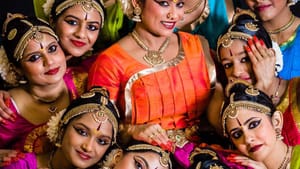Stay in the Loop
BSR publishes on a weekly schedule, with an email newsletter every Wednesday and Thursday morning. There’s no paywall, and subscribing is always free.
Math is dance
The Painted Bride presents Three Aksha

When Three Aksha founder and artistic director Viji Rao opened a recent performance at the Painted Bride by telling us that she wanted to introduce new audiences to Indian culture through the classical Bharatanatyam dance form, I expected intricate movement and brightly colored traditional costumes. I did not expect the lecture on the relationship of the dance to geometry that the first piece of the evening, Rao’s Prayog, gave us. But it was fascinating.
Triangles, circles, mandalas
The dancers, in wide gold trousers, blue half-sari tops, and gold fan skirts (a pleated panel that expands like a fan) each carried a band of stretchy white cloth that they held pinned to the floor with their feet. As they elegantly raised their arms over their heads and spread their feet, they stretched the band to mark the sides of one triangle. Arms shifted and a deep knee bend, with the dancer’s leg stretched out to the side, created another. Video designers Laia Cabarera and Isabelle Duverger created a backdrop of glowing triangles—equilateral, right, isosceles—that tumbled and multiplied on a screen behind the glittering, bejeweled dancers whose bodies created the shapes on the screen.
Dance is made of circles, the narrator said, continuing our lesson: the movement rotates around the axis of the body, always completing the circle. To illustrate, dancers turned, with sharp stamps of their upturned feet. They joined hands in a circle, while mandalas both modern and ancient took turns with the tumbling triangles on the screen behind them. Pentagons were next, and again the white band outlined the shape of the body movement. As the dance progressed, we did not need the white bands to guide our understanding, because the shapes became as clear as if we had always known them.
Turn it down
A set of Indian music by the Three Aksha Music Ensemble followed a five-minute break. The musicians were probably skilled, but the eardrum-shattering amplification ruined the effect. A small child was carried out screaming, and even with earplugs I needed to put my hands over my ears. The Painted Bride is a very small venue, so there would seem to be no need to amplify live instruments at all, let alone at this level. When I should have been enjoying the music and learning more about it, I spent my time instead praying for the volume to drop. This was no way to treat the audience or the musicians.
Chaya and children
After another five-minute interval, the dancers returned with the premiere of a new piece choreographed by Rao. If Prayong gave us dance as mathematics, then Chaya gave us dance as language. This time the dancers appeared in costumes of many bright colors, with red coloring on the hands and the feet. They stamped their feet in time to the live music and fell effortlessly into impossibly deep, wide-legged knee bends that spread their skirts like a fan. But the hands drew our attention this time, creating intricate shapes that were both graceful and meaningful. As I watched, I felt that I could almost understand the language of those hands.
The adult dancers gave way to children, some with less than four months of training. Rao is not the first teacher/choreographer to include students in a piece, and the youngest group was, frankly, adorable. It worked the first time they appeared onstage, and at a stretch the second time. But the piece was overlong in an evening that ran for three and half hours, with just those two very short breaks. By the children’s third appearance, they were clearly wilting and so was the audience.
Chaya has the feel of a work in progress. It needs to be trimmed of some of the dances of the (admittedly cute) girls and the sound needs to be brought down. The narration was difficult to hear, and would have added much to our understanding of the meaning of the dances. And given the stated goal of reaching a broader audience with the culture and dance of India, a playbill with some information we could take home would have helped greatly. But it was a wonderful exploration of dance and music, and I am looking forward to seeing what Three Aksha does next.
What, When, Where
An Evening of Music and Dance by Three Aksha. Choreography by Viji Rao. Three Aksha. July 3, 2019, at the Painted Bride Art Center, 230 Vine Street, Philadelphia. (215) 969-8603 or threeaksha.org.
The Painted Bride is a wheelchair-accessible venue.
Sign up for our newsletter
All of the week's new articles, all in one place. Sign up for the free weekly BSR newsletters, and don't miss a conversation.

 Camille Bacon-Smith
Camille Bacon-Smith